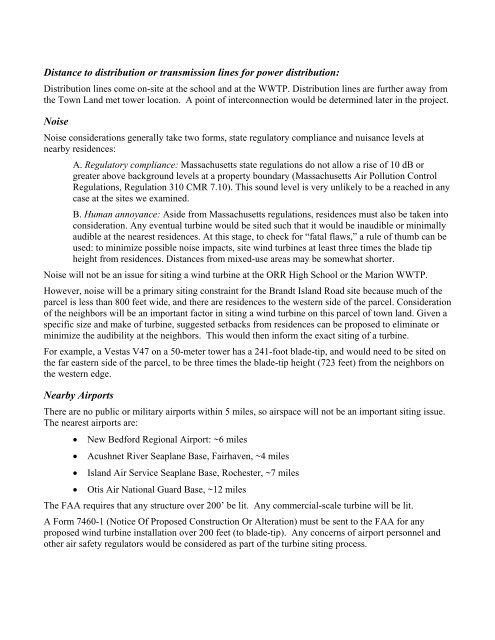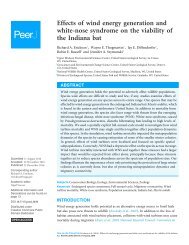Tri-Town_ORR_Preliminary_Site_Analysis
Tri-Town_ORR_Preliminary_Site_Analysis
Tri-Town_ORR_Preliminary_Site_Analysis
Create successful ePaper yourself
Turn your PDF publications into a flip-book with our unique Google optimized e-Paper software.
Distance to distribution or transmission lines for power distribution:<br />
Distribution lines come on-site<br />
at the school and at the WWTP. Distribution lines are further away from<br />
the <strong>Town</strong> Land met tower location. A point of interconnection would be determined later in the project.<br />
Noise<br />
Noise considerations generally take two forms, state regulatory compliance and nuisance levels at<br />
nearby residences:<br />
A. Regulatory compliance: Massachusetts state regulations do not allow a rise of 10 dB or<br />
greater above background<br />
levels at a property boundary (Massachusetts Air Pollution Control<br />
Regulations, Regulation 310 CMR 7.10). This sound level is very unlikely to be a reached in any<br />
case at the sites we examined.<br />
B. Human annoyance: Aside from Massachusetts regulations,<br />
residences must also be taken into<br />
consideration. Any eventual turbine would be sited such that it would be inaudible or minimally<br />
audible at the nearest residences. At this stage, to check for “fatal flaws,” a rule of thumb can be<br />
used: to minimize possible noise impacts, site wind turbines at least three times the blade tip<br />
height from residences. Distances from mixed-use areas may be somewhat shorter.<br />
Noise will not be an issue for siting a wind turbine at the <strong>ORR</strong> High School or the Marion WWTP.<br />
However, noise<br />
will be a primary siting constraint for the Brandt Island Road site because much of the<br />
parcel is less than 800 feet<br />
wide, and there are residences to the western side of the parcel. Consideration<br />
of the neighbors will be an important factor in siting a wind turbine on this parcel of town land. Given a<br />
specific size and make of turbine, suggested setbacks from residences can be proposed to eliminate or<br />
minimize the audibility at the neighbors. This would then inform the exact siting of a turbine.<br />
For example, a Vestas V47 on a 50-meter tower has a 241-foot blade-tip, and would need to be sited<br />
on<br />
the far eastern side of the parcel, to be three times the blade-tip height (723 feet) from the neighbors on<br />
the western edge.<br />
Nearby Airports<br />
There are no public or military airports within 5 miles, so airspace will not be an important siting issue.<br />
The nearest airports are:<br />
• New Bedford Regional Airport: ~6 miles<br />
• Acushnet River Seaplane Base, Fairhaven, ~4 miles<br />
• Island Air Service Seaplane Base, Rochester, ~7 miles<br />
• Otis Air National Guard Base, ~12 miles<br />
The FAA requires that any structure over 200’ be lit. Any com mercial-scale turbine will be lit.<br />
A Form 7460-1 (Notice Of Proposed Construction Or Alteration) must be sent<br />
to the FAA for any<br />
proposed wind turbine installation over 200 feet (to blade-tip). Any concerns of airport personnel and<br />
other air safety regulators would be considered as part of the turbine siting process.



